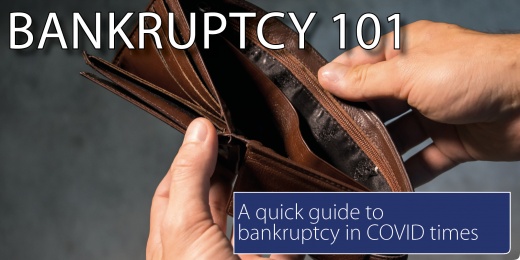Bankruptcy 101.
Share

The Covid-19 pandemic has put unprecedented financial pressure on businesses and individuals. This is our quick quite to bankruptcy in COVID times.
The Covid-19 pandemic has put unprecedented financial pressure on businesses and individuals. This will be the first in a series of articles that provides information in relation to bankruptcy and how a bankrupt estate is administered to assist people who are suffering from financial distress, in making the best possible decisions for their and their family’s future. Note that the term for a Bankrupt has recently been amended to “Regulated Debtor” to lessen the stigma associated with bankruptcy.
Appointment
There are two methods with which a person can become a Regulated Debtor. A person can become a Regulated Debtor voluntarily, by lodging a Bankruptcy Form with the Australian Financial Security Authority (“AFSA”). A person can also be made a Regulated Debtor involuntarily, which requires a creditor to make an application to Court.
Debtor’s Petition (voluntary Bankruptcy)
A person can make themselves a Regulated Debtor by lodging a “Bankruptcy Form”, which incorporates the “Debtor’s Petition” and a “Statement of Affairs”. The preferred method for completing this document is by accessing the AFSA website and creating an account on Insolvency Services. This website can be accessed at:
https://www.afsa.gov.au/insolvency/cant-pay-my-debts/apply-bankruptcy
In the event the person is unable to complete the form online, a paper form is available.
The Bankruptcy Form includes all details regarding the assets and liabilities of the individual, their personal details, their income details and what has led to their financial distress. It is important to complete the document properly and fully disclose all of your financial and personal circumstances. Failure to properly disclose information is, upon conviction, a criminal offence. Other offences related to Bankruptcy will be explained in greater detail in a later article.
By submitted the Bankruptcy Form without a Consent to Act from a Registered Trustee will mean that the Official Trustee (AFSA) will manage the Regulated Debtor Estate. In the event that the individual wishes to appoint a Registered Trustee, the Registered Trustee will be required to complete the Consent to Act Declaration and this must be submitted at the same time as the Bankruptcy Form.
Creditor’s Petition (involuntarily Bankruptcy)
A creditor can take action against an individual to force them into bankruptcy. At present, the creditor must be owed a minimum of $20,000. This amount has been increased from $5,000 as part of the Federal Government’s economic response to COVID-19. There has also been an extension in the amount of time that a person has to respond to a Bankruptcy Notice, from 21 days to six months. This means that if a creditor serves a Bankruptcy Notice upon an individual, they have six months to take action before the Bankruptcy Notice expires and the creditor can make an application to Court. At this stage the COVID-19 relief will cease on 1 January 2021.
Once a person is made a Bankrupt by the Court, they are required to complete a Statement of Affairs and submit it to AFSA. Again, the preferred method to submit the Statement of Affairs is by accessing the AFSA website and creating an account on Insolvency Services. This website can be accessed at:
https://www.afsa.gov.au/insolvency/currently-bankrupt/creditor-has-made-me-bankrupt
In the event the person is unable to complete the form online, a paper form is available.
Either method of becoming A Bankrupt requires the individual to be subject to the same rules and regulations regarding their assets, income and ongoing financial dealings. These rules and regulations will be explained further in later articles.
In the interim, if you have any questions, or your client’s are experiencing financial distress, please contact Brodie Hilet or Neil McLean on (03) 9670 8700.







